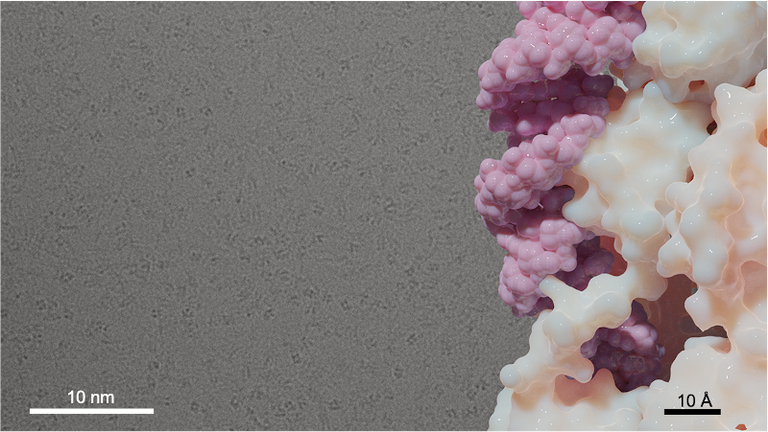Do you want to keep up to date? Subscribe to our newsletter. 1 mail every 2 months! |
 |

Cerdanyola del Vallès, 22nd June 2023 The EM01-Cryo-TEM, the transmission electron microscope located at JEMCA (Joint Electron Microscopy Center at ALBA), it is under operation since October 2022 and it is coordinated by the Institute for Molecular Biology of Barcelona (IBMB-CSIC). It is the second microscope of its kind in Spain and is key to being able to solve rapidly and with high resolution the protein structures that cannot be analysed with other techniques. Therefore, it represents a great advance for the user community in this field.
One of its first users was the group of Dr. Ernesto Arias from CIB-CSIC, who used the EM01-Cryo-TEM to analyze a type of proteins called transposases. The data helped to shed light on how transposases catalyze DNA rearrangement events with broad impacts on gene expression, genome evolution, and drug resistance in bacteria
Transposons, a particular class of mobile genetic elements, are DNA sequences that have the ability to “jump” between different nucleic acid molecules. They often encode at least one protein, the transposase, which is the enzyme responsible for performing the strand-transfer reaction. Some transposable elements are used as biotechnological tools, whereas others are showing great potential in gene editing applications.
Moreover, the DNA reshuffling activity of some transposons has had deep biological implications. More precisely, the family of transposons studied by the CIB-CSIC team is found in most bacterial phyla, including numerous clinical and multidrug-resistant strains, and has played a key role in the evolution of human pathogens such as Yersinia pestis and Yersinia pseudotuberculosis, which cause infectious diseases like plague and pseudotuberculosis respectively.
The research team used biochemical and structural approaches to define how IstA transposase engages the transposon terminal sequences to form a high-molecular-weight complex and promote DNA integration. Altogether, data demonstrate that IstA oligomerizes and associates with its cognate nucleic acid elements in a highly cooperative manner.
To check these data, researchers came to the JEMCA microscopy center, in ALBA, to carry out cryo-electron microscopy studies in the EM01-Cryo-TEM. The images obtained provided key information to resolve the structure of the transposase + transposon complex at atomic resolution. That information supported the biochemical observations and showed that the transposase forms a close-knit tetramer that engages the transposon ends with a remarkably intertwined configuration that can regulate the expression of the transposon-encoded proteins and neighboring host genes.
“Now, with this microscope we get such a great tool to efficiently unravel protein structures in 3D, as well as understand their functional context in the biological cell”, comment Dr. Pablo Guerra, scientist at IBMB-CSIC and head of the microscope at ALBA. “It enables us to take up to 300 movies per hour with information at atomic level”.
These findings provide insights into transposons transposition and reveal how numerous transposases may recognize the often-multiple terminal transposon repeats to prevent abnormal and deleterious double-strand breaks and facilitate efficient DNA reorganization events.
The acquisition of the EM01-Cryo-TEM has been possible thanks to a collaboration of different research entities: the Institute for Molecular Biology (IBMB-CSIC) acting as owner of the equipment, the ALBA Synchrotron where the microscope has been installed and is operated, the Spanish National Research Council (CSIC), the Institute for Biomedical Research (IRB Barcelona), the Centre for Genomic Regulation (CRG), and the Universitat Autònoma de Barcelona (UAB). It was co-financed by the European Regional Development Fund (ERDF), with the support of the Ministry for Research and Universities of the Government of Catalonia, through the aid for the implementation of cooperative projects for the creation, construction, acquisition and improvement of shared scientific and technological equipment and platforms, under the framework of the ERDF Operational Programme for Catalonia 2014-2020.
Reference: IS21 family transposase cleaved donor complex traps two right-handed superhelical crossings. Mercedes Spínola-Amilibia, Lidia Araújo-Bazán, Álvaro de la Gándara, James M. Berger, Ernesto Arias-Palomo (2023) Nature Commun. DOI: 0.1038/s41467-023-38071-x

With the collaboration of Fundación Española para la Ciencia y la Tecnología. The ALBA Synchrotron is part of the of the Unidades de Cultura Científica y de la Innovación (UCC+i) of the FECYT and has received support through the FCT-21-17088 project.





